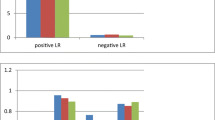Abstract
This study compared the BACTEC™ blood culture system (Becton Dickinson Diagnostic Instrument Systems, Sparks, Md) with conventional culture methods for recovery and time to detection of significant isolates from normally sterile body fluids. A total of 412 specimens were included in the study. Half of the specimens were inoculated directly into the automated blood culture system. The remaining specimens were centrifuged at 3000 rpm for 10 min and were inoculated onto conventional media. Clinically significant microorganisms were isolated from 41 specimens (10%) by both culture systems; however, for 62 specimens (14.9%), growth was detected only with the BACTEC system. No isolates were detected with only conventional culture methods. A significant difference was noted between the blood culture system and routine culture methods for recovery of pathogenic microorganisms that were from sterile body fluids. The most frequently isolated microorganisms recovered only with the blood culture system were gram-positive cocci; gram-negative bacilli were the most frequently isolated microorganisms that were recovered with both culture methods.Streptococcus pneumoniae, Streptococcus viridans,Aeromonas hydrophila, andBrucella were recovered only with the blood culture system. Furthermore, the mean time to detection of significant pathogens was significantly less with the blood culture system than with conventional media. The BACTEC blood culture system was found to improve the yield of clinically significant isolates from normally sterile body fluids with reduced time to detection; it may be advantageous for isolation of fastidious microorganisms, such asBrucella andS pneumoniae, especially from cerebrospinal and synovial fluid specimens.
Similar content being viewed by others
References
Forbes BA, Granato PA. Processing specimens for bacteria. In: Murray PR, Baron EJ, Pfaller MA, Tenover FC, Yolken RH, eds.Manual of Clinical Microbiology. 6th ed. Washington, DC: American Society of Microbiology; 1995:271.
Isenberg HD. In:Clinical Microbiology Procedures Handbook. Washington, DC: American Society of Microbiology; 1992:1–8.
Simor AE, Scythes K, Meaney H, Louie M. Evaluation of the BacT/Alert microbial detection system with FAN aerobic and FAN anaerobic bottles for culturing normally sterile body fluids other than blood.Diagn Microbiol Infec Dis. 2000;37:5–9.
Fuller DD, Davis TE, Kibsey PC, et al. Comparison of BACTEC Plus 26 and 27 media with and without fastidious organism supplement with conventional methods for culture of sterile body fluids.J Clin Microbiol. 1994;32:1488–1491.
Bourbeau P, Riley J, Heiter BJ, Master R, Young C, Pierson C. Use of BacT/Alert blood culture system for culture of sterile body fluids other than blood.J Clin Microbiol. 1998;36:3273–3277.
Yagupsky P, Press J. Use of the Isolator 1.5 microbial tube for culture of synovial fluid from patients with septic arthritis.J Clin Microbiol. 1997;35:2410–2412.
Koneman EW, Allen SD, Janda WM, Schreckenberger PC, Winn WC, eds.Color Atlas and Textbook of Diagnostic Microbiology. Philadelphia, Pa: JB Lippincott; 1997.
von Essen R. Culture of joint specimens in bacterial arthritis: impact of blood culture bottle utilization.Scand J Rheumatol. 1997;26:293–300.
Akçam FZ, Yayli G, Uskun E, Kaya O, Demir C. Evaluation of the Bactec microbial detection system for culturing miscellaneous sterile body fluids.Res Microbiol. 2006;157:433–436.
Rayner BL, Williams DS, Oliver S. Inoculation of peritoneal dialysate fluid into blood culture bottles improves culture rates.S Afr Med J. 1993;83:42–43.
Bobadilla M, Sifuentes J, Garcia-Tsao G. Improved method for bacteriological diagnosis of spontaneous bacterial peritonitis.J Clin Microbiol. 1989;27:2145–2147.
Singh N, Rihs JD, Gayowski T, Mieles L, Yu VL. Improved detection of spontaneous bacterial peritonitis with Bactec as compared with conventional culture methods: a prospective study.Diagn Microbiol Infect Dis. 1994;19:1–4.
Hughes JG, Vetter EA, Patel R, et al. Culture with BACTEC Peds Plus/F bottle compared with conventional methods for detection of bacteria in synovial fluid.J Clin Microbiol. 2001;39: 4468–4471.
Yagupsky P, Dagan R, Howard CW, Einhorn M, Kassis I, Simu A. High prevalence ofKingella kingae in joint fluid from children with septic arthritis revealed by the BACTEC blood culture system.J Clin Microbiol. 1992;30:1278–1281.
Yagupsky P, Peled N, Press J. Use of BACTEC 9240 blood culture system for detection ofBrucella melitensis in synovial fluid.J Clin Microbiol. 2001;39:738–739.
von Essen R, Hölttä A. Improved method of isolating bacteria from joint fluids by the use of blood culture bottles.Ann Rheum Dis. 1986;45:454–457.
Author information
Authors and Affiliations
Corresponding author
Rights and permissions
About this article
Cite this article
Çetin, E.S., Kaya, S., Demirci, M. et al. Comparison of the BACTEC blood culture system versus conventional methods for culture of normally sterile body fluids. Adv Therapy 24, 1271–1277 (2007). https://doi.org/10.1007/BF02877773
Issue Date:
DOI: https://doi.org/10.1007/BF02877773



